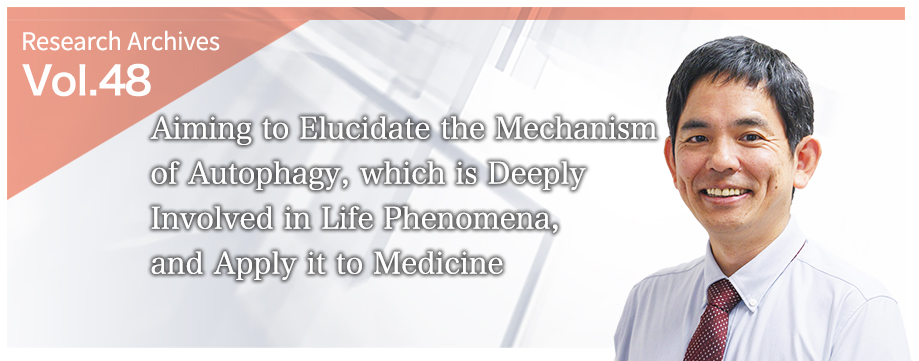
Department of Biological Molecular Mechanisms, Graduate School of Medicine, Hokkaido University
Nobuo Noda Ph.D. Immunology
- [Academic & Professional Experience]
-
- 1996 B.S. in the pharmaceutical sciences from University of Tokyo
- 1998 M.S. in the pharmaceutical sciences from University of Tokyo
- 2001 Ph.D. from University of Tokyo, Graduate School of Pharmaceutical Sciences
- 2001-2011 Postdoctoral fellow, Assistant Professor, Lecturer at Hokkaido University, Sapporo, Japan.
- 2011 to 2017 Chief Researcher at Institute of Microbial Chemistry, Tokyo, Japan.
- 2017 to 2021 Laboratory Head at Institute of Microbial Chemistry, Tokyo, Japan.
- 2022~ Professor at Institute for Genetic Medicine, Hokkaido University"
Elucidating the relationship between autophagy and liquid-liquid phase separation
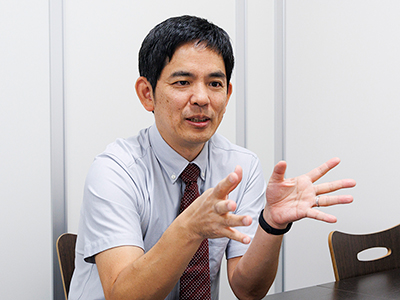
The Department of Biological Molecular Mechanisms, affiliated with the Institute for Genetic Medicine, is a new department established in 2022. Professor Nobuo Noda, who leads the department, has long been involved in structural studies of proteins, and is further engaged in in vitro reconstitution and mechanistic studies of intracellular phenomena focused on the mechanism of autophagy.
“Autophagy is a conserved self-component degradation system in eukaryotic cells whereby autophagosomes transport degrading substrates to lysosomes, which serve as intracellular degradation factories,” Professor Noda says. “Autophagy has the ability to break down everything from biomolecules such as proteins, lipids, and nucleic acids, to organelles such as mitochondria and endoplasmic reticulum, to bacteria that have invaded the cell. Using its universal degrading activity, autophagy serves to maintain homeostasis in living organisms, and it is believed that a decrease in its activity leads to neurodegenerative diseases and aging.”
In 2016, Dr. Yoshinori Ohsumi of molecular cell biology was awarded the Nobel Prize in Physiology or Medicine, raising awareness of the importance of autophagy in medicine. Recent studies have revealed that autophagy is related to various diseases, such as cancer, neurodegenerative disorders, lifestyle-related illnesses, such as diabetes, heart failure, and infectious diseases. It also has essential physiological functions in development, differentiation, aging, and immunity, and has attracted attention as a critical research area for drug discovery and treatment methods.
Dr. Ohsumi's research has identified a number of ATG genes responsible for autophagy and the Atg proteins they encode. Dr. Noda, who has been working with Dr. Ohsumi, has assumed Dr. Ohsumi's research theme and is now working on structure-function analysis of individual Atg proteins, in vitro reconstruction of various autophagy processes using purified proteins and artificial membranes, and cell biological analysis using yeast and cultured cells to gain an understanding of the mechanism of autophagy at the molecular level.
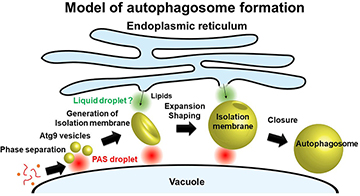
Atg proteins that have been dispersed and localized in the cytoplasm assemble to form liquid droplets by undergoing liquid-liquid phase separation, which then uses Atg9 vesicles to generate an initial isolation membrane that grows into autophagosomes by selectively taking up lipid molecules from the endoplasmic reticulum.
In 2019, while working at the Institute of Microbial Chemistry of the Microbial Chemistry Research Foundation, Professor Noda published research results showing the formation process of autophagosomes, double membrane-bound organelles that play an important role in autophagy[1].In 2020, in collaboration with Tokyo Institute of Technology, Kanazawa University, and others, he discovered that the structure responsible for autophagy progression is a liquid-like condensate of Atg proteins created through liquid-liquid phase separation. He was the first in the world to discover that liquid-liquid phase separation of proteins plays a pivotal role in the control of autophagy (Nature 2020) [2].
Professor Noda says, “Liquid-liquid phase separation is a new concept that is essential for an understanding of the behavior of biomolecules and has been shown to play an important role in various biological phenomena. In addition to autophagy, we are also working to elucidate the mechanisms of other biological phenomena involving liquid-liquid phase separation.”
[2] ^ Press release “Mechanism of controlling autophagy by liquid-liquid phase separation revealed Research of autophagy is stepping into the next phase”
Working to unravel the mysteries of life phenomena in a state-of-the-art research environment
To understand the mechanism of autophagy, which remains a mystery at the molecular level, our department is conducting research on (1) structural and functional analyses of individual Atg proteins, (2) in vitro reconstitution of autophagy processes using purified proteins and artificial membranes, and (3) cell biological analysis using yeast and mammalian cells.
Among these, in vitro reconstitution of autophagy processes using purified proteins and artificial membranes is one of the most challenging research topics. Reconstituting various membranes in a test tube using more than 20 different Atg proteins requires sophisticated techniques, and the formation process is further observed with special equipment such as high-speed atomic force microscopy and freeze-fracture replica electron microscopy. Professor Noda says, “In case of in vitro reconstitution and structural studies of autophagy, we maintain a world-class level of technology.”
Our department has achieved groundbreaking research results by utilizing state-of-the-art analytical equipment such as high-speed atomic force microscopy, confocal laser-scanning microscopy that enables observation of intracellular protein and lipid membrane dynamics, freeze-fracture replica electron microscopy that enables high-resolution visualization of cell membrane structure and lipid composition, and high-performance computers that can predict protein complex structures using AlphaFold2.
Professor Noda says, “Our research is focused on “visualization.” Whenever there is a life phenomenon of interest, it is extremely important to incorporate research methods that are appropriate to clarify the phenomenon to elucidate its mechanism. At our department we can make full use of a variety of research methods at a high technical level, and have a system in place to constantly incorporate new methods, so I think we have the best environment for those who enjoy studying the mechanisms of life phenomena.”
In recent years, in collaboration with the University of Tsukuba, our department has also been conducting research to elucidate the relationship between proteins and sleep. The aim of the research is to elucidate the molecular function of the sleep-inducing protein Nemuri, which has been identified in Drosophila.
“Nemuri is an intrinsically disordered protein that has no three-dimensional structure and is thought to be associated with liquid-liquid phase separation. We are working on the hypothesis that sleep may be induced by the liquid-liquid phase separation of proteins in the brain,” says Professor Noda.
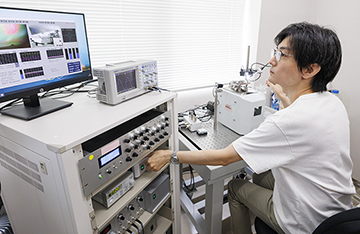
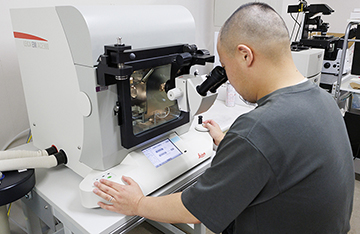
(Interviewed in September 2023)
A group of research professionals working closely with other universities and research institutions
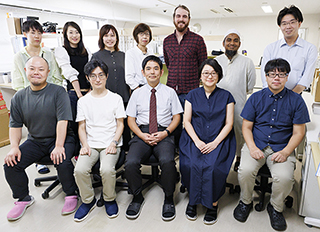
Our department consists of a professor, an associate professor, a specially appointed lecturer, an assistant professor, and a specially appointed assistant professor, three postdoctoral fellows, three technical assistants, and a secretary, who form a team of research professionals. The department works closely with the Laboratory of Structural Biology at the Institute of Microbial Chemistry, Tokyo, and joint online seminars are held every other week. The Institute of Microbial Chemistry is conducting protein structure analysis using state-of-the-art methods such as cryo-electron microscopy and solution NMR, and is also developing autophagy regulators using the library of microorganisms, and our department can share in the latest results of these studies. Four laboratories conducting advanced research on autophagy also hold joint online seminars once a month and a workshop-like study meeting once a year to deepen exchanges with other laboratories.


